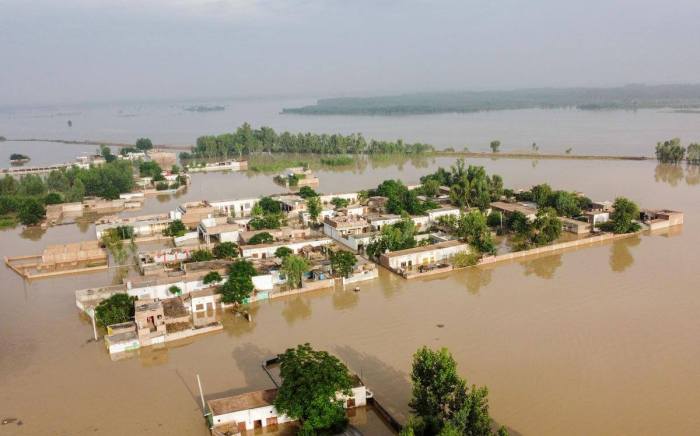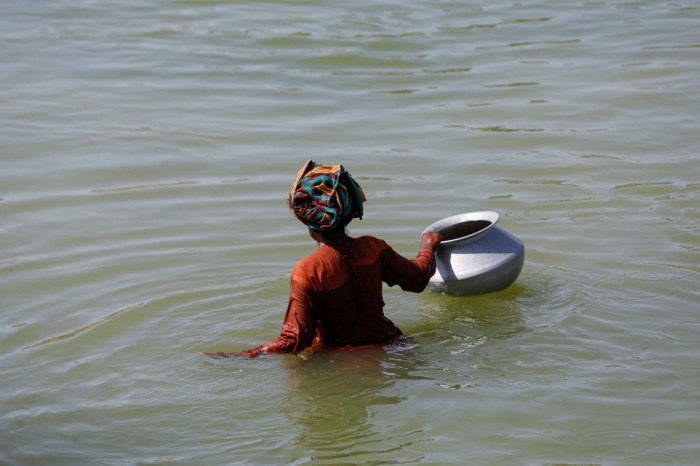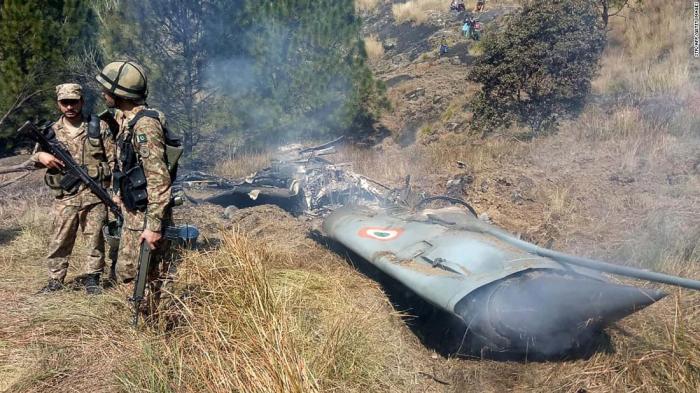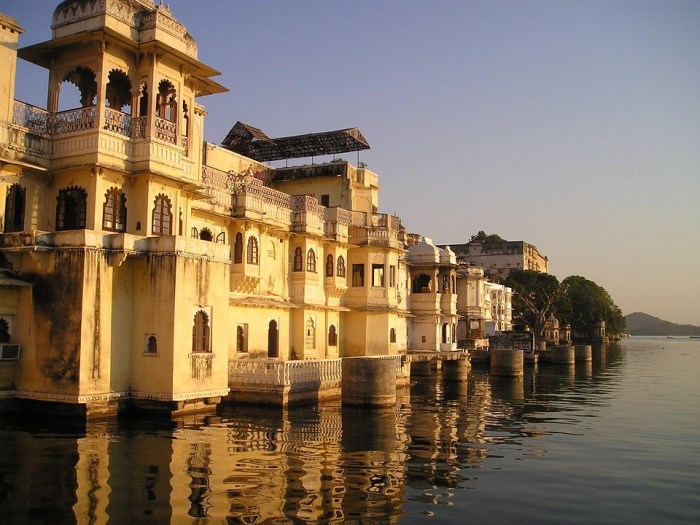
India pakistan water supply climate change – India-Pakistan water supply climate change is a complex issue with deep historical roots and escalating implications. From the shared rivers and historical agreements to the projected impacts of a changing climate, the struggle for water resources is not just a regional problem, but one with far-reaching consequences for both countries. This blog post explores the intricate web of water-sharing agreements, the devastating effects of climate change on water availability, and the potential for cooperation in managing this precious resource.
The historical tension between India and Pakistan over water resources is deeply intertwined with their political relationship. Past disputes, crises, and the role of international organizations in mediating these conflicts have shaped the current landscape. This post examines the historical context, analyzing water usage patterns, allocation agreements, and the impact of historical events on current challenges.
Shared Water Resources
The Indus River system, a lifeline for both India and Pakistan, has historically been a source of contention and cooperation. The intricate relationship between water resources and geopolitical dynamics has shaped the region’s history and continues to influence its future. Navigating the complexities of water sharing requires careful consideration of historical context, political realities, and the potential for sustainable solutions.The shared river system, vital for agriculture and human sustenance, is a delicate balance of cooperation and competition.
The historical and ongoing disputes over water allocation highlight the need for effective management strategies, equitable agreements, and the recognition of the interconnectedness of water resources and regional stability.
Historical Overview of Water-Sharing Agreements and Disputes
The Indus Waters Treaty, signed in 1960, represents a landmark agreement for sharing the waters of the Indus River system between India and Pakistan. It divides the rivers into Eastern and Western rivers, assigning specific water rights to each country. This treaty, while intended to ensure long-term cooperation, has faced challenges in implementation and interpretation, particularly during periods of heightened political tension.
The water crisis between India and Pakistan is a serious issue exacerbated by climate change. It’s a complex problem, but surprisingly, similar struggles are reflected in some of the most captivating storytelling ever created. According to a recent AI analysis, the top 10 TV shows of all time, as determined by AI , showcase profound human challenges.
Ultimately, these fictional dramas, despite their different settings, remind us of the interconnectedness of humanity and the enduring need for cooperation in real-world situations like the India-Pakistan water supply conflict.
Impact of Historical Events and Political Tensions on Water Allocation
Political tensions and conflicts have significantly impacted the implementation of the Indus Waters Treaty. Instances of military standoffs and diplomatic disagreements have often led to uncertainties in water allocation, causing water shortages in affected regions and hindering agricultural development. The fluctuating geopolitical landscape often casts a shadow over water-sharing agreements, making it challenging to maintain consistent and reliable water supplies.
Examples of Past Water-Related Crises and Their Consequences
Historical droughts and floods, coupled with political instability, have created significant water-related crises. These crises have had devastating consequences for agriculture, impacting food security and livelihoods. The interplay of natural disasters and human-induced conflicts has created a complex challenge for both countries. For example, the 2010 floods in Pakistan, exacerbated by political disputes over water release, resulted in widespread damage and displacement.
Role of International Organizations in Mediating Water Disputes
International organizations, such as the World Bank, have played a crucial role in facilitating dialogues and mediating disputes between India and Pakistan. Their technical expertise and neutral stance have been invaluable in promoting cooperation and finding common ground. However, their ability to influence the political dynamics of the region remains limited.
Comparison of Water Usage Patterns in India and Pakistan
India and Pakistan have significantly different water usage patterns. India’s growing population and agricultural demands put immense pressure on water resources, while Pakistan’s agricultural sector, particularly reliant on irrigation, is also highly vulnerable to water scarcity. Understanding these contrasting patterns is crucial to developing tailored water management strategies for each country.
Key Rivers Shared by Both Countries and Their Respective Water Allocation Agreements
| River | Water Allocation (India/Pakistan) |
|---|---|
| Indus | (Details of Allocation Agreement) |
| Chenab | (Details of Allocation Agreement) |
| Ravi | (Details of Allocation Agreement) |
| Beas | (Details of Allocation Agreement) |
| Sutlej | (Details of Allocation Agreement) |
Note: Specific details of water allocation agreements for each river are omitted for brevity. Detailed information can be found in publicly available documents concerning the Indus Waters Treaty.
Climate Change Impacts

Climate change is poised to dramatically reshape the water resources landscape of the Indo-Pakistani region, exacerbating existing tensions and creating new challenges. The region’s complex hydro-meteorological systems, already vulnerable to variability, are now projected to face increasingly unpredictable and severe impacts. This will necessitate collaborative adaptation strategies and proactive water management policies to mitigate the escalating risks.The projected impacts of climate change on water availability in the region are multifaceted and deeply concerning.
Changes in precipitation patterns, increased frequency of extreme weather events, and glacier melt are all converging to create a water crisis with far-reaching consequences. The existing infrastructure and water management systems, often strained by population growth and agricultural demands, will be further tested by these evolving conditions.
Projected Impacts on Water Availability
Changes in precipitation patterns are a significant concern. While some areas might experience increased rainfall, others will likely face prolonged periods of drought. This variability will lead to uneven water distribution, impacting agricultural productivity, human health, and overall economic stability. The delicate balance of the region’s river systems, crucial for both countries, is at risk. Furthermore, altered snowmelt patterns and glacial retreat are adding another layer of complexity to water resource management.
Increased Floods and Droughts
The region’s susceptibility to extreme weather events is escalating. Increased flood risks will strain existing infrastructure and displace populations, while droughts will severely limit water availability for agriculture and human consumption. Recent instances of devastating floods and prolonged droughts in the region highlight the growing vulnerability to these extreme events. For example, the 2010 floods in Pakistan caused widespread devastation, underscoring the vulnerability of the region’s infrastructure and population.
Conversely, prolonged droughts can lead to agricultural losses, impacting food security, and increasing competition for limited water resources.
Effect of Changing Precipitation Patterns
Altered precipitation patterns, characterized by both increased intensity and variability, will disrupt existing water resource management systems. Increased rainfall in some areas may lead to flooding, while reduced rainfall in others will exacerbate existing water scarcity. This inconsistency necessitates a proactive approach to water storage and distribution, including the development of sophisticated early warning systems for both floods and droughts.
For instance, the Himalayan region, a crucial source of water for both countries, is experiencing accelerated glacial melt, which contributes to changing precipitation patterns.
Regional Vulnerability to Water Scarcity
The vulnerability to water scarcity varies across different regions within both India and Pakistan. Mountainous regions, often reliant on glacier melt for water, are especially susceptible to glacial retreat and changing precipitation patterns. Low-lying areas are more prone to flooding, while inland regions are vulnerable to droughts. This differential vulnerability highlights the need for tailored adaptation strategies.
Potential for Increased Competition for Water Resources
Climate change-induced water scarcity is likely to heighten competition for water resources between India and Pakistan. Shared river systems, already subject to historical disputes, will face increased pressure as water availability decreases. Cooperation and equitable water-sharing agreements are crucial to mitigating potential conflicts and ensuring sustainable water management for both countries. The Indus River, a vital shared resource, is likely to experience significant changes in flow patterns due to climate change, leading to increased competition for water.
Projected Changes in Water Availability
| River | Projected Change in Water Availability (2075 – 2025) | Impact |
|---|---|---|
| Indus River | -15% to -25% | Significant decrease in water flow, increasing water stress and competition. |
| Ganga River | -10% to -20% | Decreased water availability, impacting downstream agriculture and water supply. |
| Brahmaputra River | -5% to -15% | Reduced water availability, potentially impacting flooding and drought patterns. |
Projected changes in water availability are based on various climate models and are subject to uncertainty. The actual changes may vary depending on regional specifics.
Water Management Strategies
The shared Indus River basin, a vital source of water for both India and Pakistan, faces significant challenges in equitable water allocation and efficient management. Historically, disagreements over water rights and differing approaches to water management have exacerbated tensions. This section explores current strategies, highlighting both successes and shortcomings, and suggests potential improvements to ensure sustainable water use in the region.Current water management strategies in India and Pakistan reflect a complex interplay of governmental policies, societal needs, and technological capabilities.
Both countries have implemented various measures, but the effectiveness varies based on factors like geographical conditions, population density, and economic development.
Current Water Management Strategies in India
India’s water management strategies are multifaceted, encompassing large-scale dam projects, canal irrigation systems, and localized rainwater harvesting initiatives. The country’s extensive network of dams plays a crucial role in storing water for irrigation and hydropower generation. However, the environmental impacts of large dams, including displacement of communities and disruptions to ecosystems, are a major concern. Furthermore, water allocation policies often prioritize agricultural needs, which can lead to water scarcity for other sectors.
Current Water Management Strategies in Pakistan
Pakistan’s water management strategies are heavily reliant on the Indus River system. The country has a network of canals and reservoirs, but the system is aging and often faces operational challenges. Furthermore, climate change impacts, such as altered rainfall patterns and increased variability, further strain water resources. Additionally, inefficient irrigation practices contribute to water wastage.
Comparing the Effectiveness of Strategies
The effectiveness of water management strategies in both countries is difficult to quantify due to the multitude of factors involved. While India’s large-scale projects provide significant water storage capacity, the ecological and social costs are considerable. Pakistan’s reliance on the Indus River system, susceptible to fluctuations in flow and water availability, poses ongoing challenges. Both nations could benefit from a more integrated and comprehensive approach that considers environmental sustainability alongside economic needs.
Potential Strategies for Improving Water Efficiency and Conservation
Improving water efficiency and conservation is crucial. Strategies include promoting drip irrigation techniques, implementing water-efficient agricultural practices, and encouraging water conservation measures in urban areas. Additionally, stricter enforcement of water usage regulations and promoting public awareness campaigns can play a significant role.
Examples of Innovative Water Management Techniques
Innovative water management techniques are emerging, including the use of treated wastewater for irrigation and the development of smart irrigation systems. Furthermore, rainwater harvesting techniques, often combined with local storage solutions, offer promising approaches for increasing water availability in arid and semi-arid regions.
Role of Technology in Enhancing Water Management
Technology plays a crucial role in improving water management. Remote sensing technologies, such as satellite imagery, provide valuable data for monitoring water resources and assessing water availability. Furthermore, data analytics and modeling tools can help predict water needs and optimize water allocation strategies. The use of smart irrigation systems and sensors can also improve water efficiency.
Contrasting Water Storage and Distribution Methods
| Method | India | Pakistan | Description |
|---|---|---|---|
| Large Dams | Extensive | Significant | Provides large-scale storage, but can have significant environmental impacts. |
| Canals | Extensive network | Extensive network | Facilitates water distribution, but can be inefficient. |
| Rainwater Harvesting | Growing use | Limited use | Collects and stores rainwater for later use. |
| Groundwater Extraction | Significant | Significant | Provides a readily available source, but can lead to depletion of aquifers. |
Transboundary Cooperation

The Indus River, a lifeline for millions in both India and Pakistan, is a stark example of the complex challenges and opportunities presented by shared water resources. Effective transboundary cooperation is crucial for managing water resources equitably and sustainably, especially in the face of climate change. Such cooperation goes beyond mere technical solutions; it necessitates strong political will, mutual trust, and a commitment to shared understanding.
India and Pakistan’s water supply woes are deeply intertwined with climate change, creating a tense situation. The ongoing struggles over water resources are exacerbated by geopolitical factors, and unfortunately, the issue is likely to worsen. This reminds me of the complex trade negotiations between China and the US during the Trump administration, particularly the china trade talks trump , which also highlighted the difficulties in international cooperation when powerful actors have conflicting interests.
Ultimately, finding sustainable solutions for water management in the region will require a multifaceted approach, involving both diplomatic and environmental strategies.
Importance of Transboundary Cooperation
Transboundary water management is essential for equitable and sustainable water use. Cooperation fosters stability, reduces conflict potential, and allows for the development of comprehensive strategies that address the needs of all riparian states. This includes addressing issues like water allocation, infrastructure development, environmental protection, and adaptation to climate change impacts. Sharing data and knowledge becomes vital for informed decision-making, preventing disputes, and promoting joint initiatives.
Examples of Successful Transboundary Water Management Initiatives
Several successful transboundary water management initiatives exist globally, showcasing the benefits of cooperation. The Mekong River Commission, for instance, has established a framework for cooperation among riparian states in Southeast Asia. The sharing of data, joint monitoring programs, and collaborative water resource planning have facilitated equitable water allocation and enhanced environmental protection. Similarly, the Nile River Basin Initiative promotes cooperation among riparian countries in the Nile Basin.
Potential Barriers to Cooperation Between India and Pakistan
Historical tensions and political disputes can significantly hinder cooperation between India and Pakistan. Differing perspectives on water allocation, concerns about the reliability of data sharing, and mistrust between the two nations have created obstacles to collaborative water management. These factors are compounded by the complex political environment and a history of disputes.
Enhanced Communication and Trust Building
Fostering communication and trust is crucial for overcoming barriers to cooperation. Regular dialogue, joint technical assessments, and confidence-building measures can help build mutual understanding and reduce suspicions. This involves open channels of communication, facilitated by neutral third parties, and the development of mechanisms for dispute resolution.
Shared Data and Information Systems
Shared data and information systems are essential for effective transboundary water management. Access to reliable and up-to-date hydrological data, including rainfall patterns, river flow rates, and reservoir levels, allows for informed decision-making. This data should be accessible and shared through established protocols and standardized formats, allowing for transparent and accountable water resource management.
Possible Frameworks for Strengthening Transboundary Cooperation on Water Resources
| Framework Element | Description |
|---|---|
| Joint Water Resource Management Plan | A comprehensive plan outlining shared objectives, responsibilities, and strategies for water resource management. This would encompass water allocation, infrastructure development, environmental protection, and adaptation to climate change. |
| Joint Monitoring and Data Sharing Mechanism | A mechanism for collecting, analyzing, and sharing hydrological data, including rainfall, river flow, and reservoir levels, using standardized protocols and formats. |
| Dispute Resolution Mechanisms | Established procedures for resolving disputes and disagreements concerning water allocation and use. This could involve mediation, arbitration, or other forms of conflict resolution. |
| Confidence-Building Measures | Initiatives to enhance trust and cooperation, such as joint technical assessments, training programs, and information exchanges. |
| Capacity Building Programs | Programs to enhance the technical and managerial expertise of water resources personnel in both countries. |
Socioeconomic Impacts
Water scarcity, a growing concern in the Indo-Pakistani region, is not merely a hydrological issue. Its impact reverberates through the socioeconomic fabric of both nations, affecting livelihoods, economic growth, and the overall well-being of their populations. The interconnectedness of water resources and human development underscores the urgent need for collaborative solutions to address this shared challenge.The consequences of water scarcity extend far beyond the immediate availability of this vital resource.
It fundamentally alters the economic landscape, impacting agricultural output, industrial productivity, and ultimately, human health and well-being. Understanding these socioeconomic impacts is crucial for crafting effective water management strategies and fostering sustainable development in the region.
The escalating water scarcity issues between India and Pakistan, exacerbated by climate change, are a serious concern. Political tensions surrounding this issue, unfortunately, often overshadow the need for collaborative solutions. Meanwhile, a recent speech by former President Trump at Arlington National Cemetery on Memorial Day, as seen in trump memorial day speech arlington , highlighted the importance of national unity.
Ultimately, focusing on international cooperation and finding sustainable solutions for water management in the region is crucial to easing tensions and ensuring a stable future for both nations.
Agricultural Impacts
Water is the lifeblood of agriculture in the Indo-Pakistani region. Declining water availability directly translates to reduced crop yields, impacting food security and farmers’ incomes. Droughts and water stress often lead to crop failures, forcing farmers to abandon their lands or adopt unsustainable practices, further exacerbating the problem. For example, the 2000-2001 drought in Pakistan resulted in significant crop losses, highlighting the vulnerability of agricultural systems to water scarcity.
The shift towards water-intensive crops, often driven by market demand, further strains water resources, creating a vicious cycle.
Industrial Impacts
Water is indispensable for industrial processes. Water scarcity hinders industrial growth and economic diversification in both countries. Reduced water availability restricts manufacturing operations, potentially leading to job losses and economic stagnation. Industries heavily reliant on water, such as textiles and food processing, face significant challenges in maintaining productivity. This can be seen in the decreased output of some factories in India and Pakistan due to water shortages.
Industries may be forced to relocate to areas with more readily available water resources, impacting local economies.
Human Health Impacts
Water scarcity has profound implications for public health. Insufficient access to safe drinking water increases the risk of waterborne diseases, particularly in vulnerable communities. Contaminated water sources and inadequate sanitation contribute to health problems, impacting productivity and placing a strain on healthcare systems. Lack of access to clean water and sanitation also disproportionately affects women and children, hindering their development and perpetuating cycles of poverty.
Livelihoods and Economic Development
Water scarcity directly impacts livelihoods. Reduced agricultural output and industrial stagnation contribute to poverty and inequality. Farmers and workers in affected sectors face economic hardship, potentially leading to migration in search of better opportunities. Water-related conflicts can further destabilize communities and hinder development efforts. For instance, disputes over water sharing between communities can lead to social unrest and hinder economic progress.
Displacement and Migration
Water scarcity can trigger displacement and migration as communities seek more sustainable livelihoods. Forced displacement can lead to social and economic disruption, potentially exacerbating existing inequalities. In regions where water resources are severely limited, people may be forced to migrate to urban centers or other areas in search of water and economic opportunities. This can place a strain on urban infrastructure and resources.
Role of Water Access in Poverty Reduction
Access to clean and sufficient water is a fundamental human right and a critical factor in poverty reduction and development. Improved water access enables better hygiene practices, boosts agricultural productivity, and supports industrial growth, creating economic opportunities and improving overall well-being. Investing in water infrastructure and promoting sustainable water management practices are crucial for poverty alleviation and sustainable development in the region.
Socioeconomic Sectors Affected by Water Scarcity
| Socioeconomic Sector | India | Pakistan |
|---|---|---|
| Agriculture | Reduced crop yields, food insecurity, farm abandonment | Reduced crop yields, livestock losses, decreased agricultural output |
| Industry | Industrial slowdown, job losses, relocation of factories | Industrial slowdown, job losses, reduced industrial output |
| Human Health | Increased risk of waterborne diseases, reduced access to sanitation | Increased risk of waterborne diseases, reduced access to sanitation |
| Livelihoods | Economic hardship, reduced incomes, migration | Economic hardship, reduced incomes, migration |
| Economic Development | Stagnation in economic growth, reduced investment | Stagnation in economic growth, reduced investment |
International Relations & Diplomacy
The intricate relationship between India and Pakistan, marked by historical tensions and shared vulnerabilities, significantly impacts the management of shared water resources. The Indus River system, a lifeline for both nations, has become a focal point of geopolitical complexities, often intertwined with broader political and security concerns. Understanding the historical context, the role of water as a political tool, and the potential for cooperation is crucial for finding sustainable solutions.
Historical Overview of Political Dynamics
The relationship between India and Pakistan has been fraught with conflict since their independence in 1947. Partition led to mass migration and violence, setting the stage for a tense relationship characterized by mistrust and border disputes. Subsequent wars and skirmishes further solidified these divisions, often exacerbated by differing interpretations of historical events and regional power dynamics. This historical context significantly influences the current approach to water resource management and cooperation.
Water as a Political Tool
Water has consistently been employed as a strategic tool in the complex relationship between India and Pakistan. The control over water resources can influence agricultural output, economic stability, and overall power dynamics. This can manifest in the form of water-related disputes, or by leveraging access to water for political leverage. These dynamics underscore the critical need for a cooperative and transparent approach to water resource management.
Strategies for Promoting Trust and Cooperation
Establishing trust and fostering cooperation between India and Pakistan requires a multi-faceted approach. Building confidence-building measures (CBMs) that involve joint water projects and transparent data sharing can be pivotal. These measures can promote a sense of shared responsibility and mutual benefit. Furthermore, the involvement of neutral mediators or international organizations can facilitate dialogue and address concerns objectively.
Joint scientific research and technical cooperation can also increase understanding and promote a collaborative approach to water management.
Role of International Diplomacy in Facilitating Water Agreements
International diplomacy plays a crucial role in mediating and facilitating water agreements between India and Pakistan. International organizations, such as the United Nations, can provide a platform for dialogue, negotiation, and conflict resolution. The involvement of neutral parties can help to de-escalate tensions and foster a more collaborative environment. Past examples of international mediation in water disputes offer valuable lessons and strategies for future negotiations.
Role of Regional Organizations in Addressing Water-Related Issues
Regional organizations, such as the South Asian Association for Regional Cooperation (SAARC), can play a vital role in addressing water-related issues in the South Asian region. These organizations can facilitate cooperation, knowledge-sharing, and the development of regional strategies for sustainable water management. They can also serve as platforms for dialogue and collaboration among member states, creating opportunities for joint initiatives in water-related projects.
History of Major Water-Related Agreements and Disputes
| Agreement/Dispute | Description | Outcome |
|---|---|---|
| Indus Waters Treaty (1960) | A landmark agreement dividing the Indus River system’s waters between India and Pakistan. | Established a framework for water sharing, although disputes over implementation have persisted. |
| Specific Water-Related Disputes (ongoing) | Ongoing disputes over water allocation, reservoir management, and water quality. | These disputes often involve technical and political complexities, necessitating continued dialogue and mediation efforts. |
Case Studies & Examples: India Pakistan Water Supply Climate Change
The intricate relationship between India and Pakistan, coupled with the shared water resources, necessitates a deeper understanding of practical applications and lessons learned. Examining specific case studies allows for a more tangible grasp of the challenges and potential solutions related to water scarcity, climate change impacts, and transboundary cooperation. Analyzing successful projects and past crises provides valuable insights into effective water management strategies.The following sections delve into specific case studies, highlighting the impact of climate change, successful water management projects, and lessons from past water-related crises, ultimately aiming to provide a more nuanced perspective on the complex water issues facing both nations.
Case Study: The Indus River Basin Water Scarcity
The Indus River Basin, a crucial source of water for both India and Pakistan, is facing increasing water scarcity due to a combination of factors, including climate change impacts, population growth, and unsustainable agricultural practices. Droughts are becoming more frequent and severe, leading to reduced water availability for irrigation and domestic use. The region’s vulnerability is exacerbated by the transboundary nature of the river system, necessitating cooperation and shared responsibility for water management.
The variability in rainfall patterns and glacier melt in the Himalayas is further impacting the availability of water resources.
Example of a Successful Water Management Project
The Sardar Sarovar Dam project in India, while controversial, exemplifies large-scale water management initiatives. The project aims to provide irrigation water to vast agricultural lands, potentially improving food security and rural livelihoods. The project demonstrates the potential of large-scale infrastructure projects to address water scarcity issues. However, the social and environmental impacts of such projects must be carefully considered.
Potential negative impacts include displacement of communities and altered ecological balance.
Lessons Learned from Past Water-Related Crises
The 2000-2002 water crisis in the Indus Basin serves as a crucial case study, illustrating the detrimental effects of inadequate water management and the necessity of cooperation. The lack of agreement and proactive measures resulted in heightened tensions and disputes between the two nations. The crisis highlighted the critical importance of establishing and adhering to clear water-sharing agreements and establishing mechanisms for conflict resolution.
Impact of Climate Change on Water Availability
Glacier melt in the Himalayas, a crucial source of water for the Indus River, is accelerating due to climate change. This shift in water availability patterns directly affects both India and Pakistan. The unpredictable nature of glacier melt and reduced snowpack are causing water shortages and threatening water security in the region. This is a direct consequence of rising temperatures and altered precipitation patterns, which further emphasizes the urgency of climate change mitigation strategies.
Example of a Transboundary Water Management Agreement
The Indus Waters Treaty (IWT), signed in 1960, is a significant example of a transboundary water management agreement. The treaty Artikels the sharing of the Indus River system’s waters between India and Pakistan, establishing specific allocations and dispute resolution mechanisms. The treaty’s success in preventing major conflicts over water resources demonstrates the importance of international cooperation and legally binding agreements.
Summary Table of Case Studies
| Case Study | Region | Key Features | Outcomes |
|---|---|---|---|
| Indus River Basin Water Scarcity | Indus River Basin | Climate change impacts, population growth, unsustainable agriculture | Increased water scarcity, reduced water availability, heightened tensions |
| Sardar Sarovar Dam Project | India | Large-scale water management initiative | Potential for improved irrigation, food security, and rural livelihoods; however, potential for social and environmental impacts |
| 2000-2002 Water Crisis | Indus Basin | Inadequate water management, lack of cooperation | Heightened tensions, critical need for cooperation and clear agreements |
| Impact of Climate Change on Water Availability | Himalayas | Accelerated glacier melt, altered precipitation patterns | Water shortages, threat to water security |
| Indus Waters Treaty (IWT) | Indus River Basin | Transboundary water management agreement | Successful in preventing major conflicts over water resources, demonstrating importance of international cooperation |
Future Scenarios
The future of water availability in the Indo-Pakistani region is deeply intertwined with climate change projections and human choices. Predicting precise outcomes is complex, but examining potential scenarios provides a framework for understanding the challenges and opportunities. Understanding these future possibilities is crucial for developing adaptive strategies and fostering cooperation.
Potential Future Scenarios for Water Availability
The region faces diverse future scenarios, from gradual decline to abrupt shifts in water availability. These scenarios are influenced by factors like changing precipitation patterns, glacier melt rates, and human water management practices.
- Scenario 1: Gradual Decline in Water Availability: This scenario envisions a progressive reduction in water resources due to prolonged drought conditions and altered hydrological cycles. This slow, but consistent, decrease will strain existing water infrastructure and intensify competition among users. The gradual nature of the decline may allow for adaptation but could lead to long-term socioeconomic consequences if not addressed proactively.
- Scenario 2: Erratic Water Fluctuations: This scenario features unpredictable and extreme weather events, including more frequent and intense floods followed by prolonged droughts. Water availability would exhibit significant variability, making long-term planning and resource management incredibly challenging. This volatility could lead to sudden and intense water shortages in some areas and excessive flooding in others, requiring substantial investments in flood control and drought-resistant infrastructure.
- Scenario 3: Accelerated Glacial Melt and Increased Flooding: Rapid glacier melt in the Himalayas, triggered by rising temperatures, could lead to increased river flows, potentially causing more frequent and severe floods. This could inundate low-lying areas and damage infrastructure, necessitating immediate measures to manage flood risks. However, subsequent periods of reduced river flow could also lead to water shortages further downstream.
Impact of Climate Change Projections
Climate change models project varying degrees of warming and altered precipitation patterns. These projections translate into differing impacts on water availability. For example, a 2°C increase in temperature could significantly reduce snowpack and glacier melt, leading to lower river flows during the dry season. A 4°C increase, however, might result in more frequent and intense extreme weather events, leading to both flooding and drought conditions.
The precise impact of these projections is highly dependent on regional variations and the specific models used.
Potential for Conflict over Water Resources
Scarcity of water resources can exacerbate existing tensions between India and Pakistan. Competition for shared water sources, coupled with varying climate change impacts, could potentially lead to conflict. Addressing these potential issues requires strong diplomatic efforts and proactive water management strategies.
Importance of Adaptive Management Strategies
Implementing adaptive management strategies is crucial for navigating the uncertain future of water resources. This includes investing in water storage facilities, developing drought-resistant crops, and improving water use efficiency in agriculture and industry. Flexibility in planning and the ability to adjust to changing conditions are vital.
Role of International Support and Cooperation, India pakistan water supply climate change
International support and cooperation are essential for building resilience to climate change impacts on water resources. This involves sharing best practices, providing technical assistance, and funding crucial infrastructure projects. Joint initiatives can promote sustainable water management and address the shared challenges effectively.
Table: Contrasting Future Scenarios and Implications
| Scenario | Water Availability | Impact on Agriculture | Socioeconomic Impact | International Relations |
|---|---|---|---|---|
| Gradual Decline | Progressive reduction in water resources | Reduced crop yields, increased irrigation costs | Increased poverty, food insecurity | Potential for heightened tensions |
| Erratic Fluctuations | Unpredictable and extreme weather events | Crop failures, increased vulnerability to drought | Disrupted livelihoods, increased displacement | Need for emergency aid and crisis management |
| Accelerated Glacial Melt | Increased river flows followed by reduced flows | Potential for floods, followed by drought | Displacement, infrastructure damage, water shortages | Enhanced cooperation in disaster relief and water sharing |
Concluding Remarks
In conclusion, the India-Pakistan water supply crisis, exacerbated by climate change, highlights the urgent need for transboundary cooperation. Addressing the multifaceted challenges requires a comprehensive approach, including innovative water management strategies, enhanced communication, and a commitment to building trust. The future of this vital resource depends on the ability of both countries to work together, learning from past mistakes and embracing sustainable solutions.







